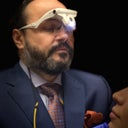Thank you for your question and for sharing your photograph Shellhutch. I understand your concern. Botox is a purified protein used to address wrinkles associated with facial expression. When injected into the skin Botox will relax the muscles and smoothen out the overlying wrinkles. The most common areas of treatment are in the upper face. These include the horizontal lines seen on the upper forehead when one raises the brows, the vertical lines seen between the brows when one frowns (frown lines), and the crow's feet seen around the eyes when one smiles.It is difficult to make an assessment without a formal exam in the office where I can view the skin in multiple angles and observe wrinkles formed with facial expression. However, I hope the information provided here is useful.In addition to addressing various wrinkles, Botox can also be used to adjust the position and shape of the eyebrows. It works the same way as it does when addressing wrinkles, namely by relaxing muscles. In the upper forehead, there are muscles that move the eyebrows up and other muscles that move the eyebrows down. The muscle that moves the eyebrows up is on the upper forehead; this is called the frontalis muscle. It is responsible for the horizontal lines seen on the upper forehead when one raises the eyebrows. The muscles that pull down on the eyebrows are located between the eyebrows and at the corners of the eyebrows. The muscle group between the eyebrows is called the glabellar complex. There is another muscle that goes around the entire eye called the orbicularis oculi muscle. The portion of this muscle under the tail of the eyebrow is responsible for pulling down on the tail of the eyebrow. When any of these muscles is relaxes with Botox the position of the eyebrow can be adjusted. When treating the horizontal lines on the upper forehead seen when one raises the eyebrows, if the dose is too high or if the placement of the product is too low it can lead to the feeling of a heavy eyebrow, difficulty raising the eyebrow, or downward movement of the eyebrow. This can also lead to downward movement of the eyelids, making a person appear tired. It also can make it difficult to apply eye makeup. To correct this Botox is placed in the antagonistic muscles, those in the glabella and orbicularis oculi which pull down on the eyebrows. This will raise the position of the eyebrows. These two areas can be treated with Botox to provide a brow lift. To do so 4-20 units of Botox are used in the glabella between the eyebrows and 2-12 units of Botox per side are used at the tail of the brow and/or the entire crow’s feet region. If there is baseline asymmetry in the position of the brows, some Botox can be placed on the upper forehead on the side with the higher brow and some Botox can be placed at the tail of the brow on the side with the lower brow.With any injection, there are risks such as pain, bleeding, bruising, redness, swelling, tenderness, and infection. We take special precautions to minimize these risks such as using a painless technique. We also treat bruises with a laser as early as the next day. Bruises usually resolve within two weeks if untreated. After a laser treatment bruises usually resolve in 1-3 days, but may still take two weeks for full resolution. In addition to these risks, with Botox there is also a risk that the product spreads or diffuses to nearby structures. Spread to nearby muscles can lead to side effects such as the temporary appearance of droopy eyelids or a temporary asymmetric smile.After a Botox treatment, I recommend that my patients avoid heat exposure, alcohol consumption, and strenuous exercise for 24 hours and not lie down flat for four hours. This is because all of these activities may possibly lead to the movement of the product and consequent side effects such as droopy eyelids as described above. Although there have been no definitive studies shown that these actually occur and some physicians do not provide such aftercare instructions, in the absence of data I err on the side of caution and recommend that my patients avoid such activities.Please consult with a doctor for specific recommendations. Good luck!







